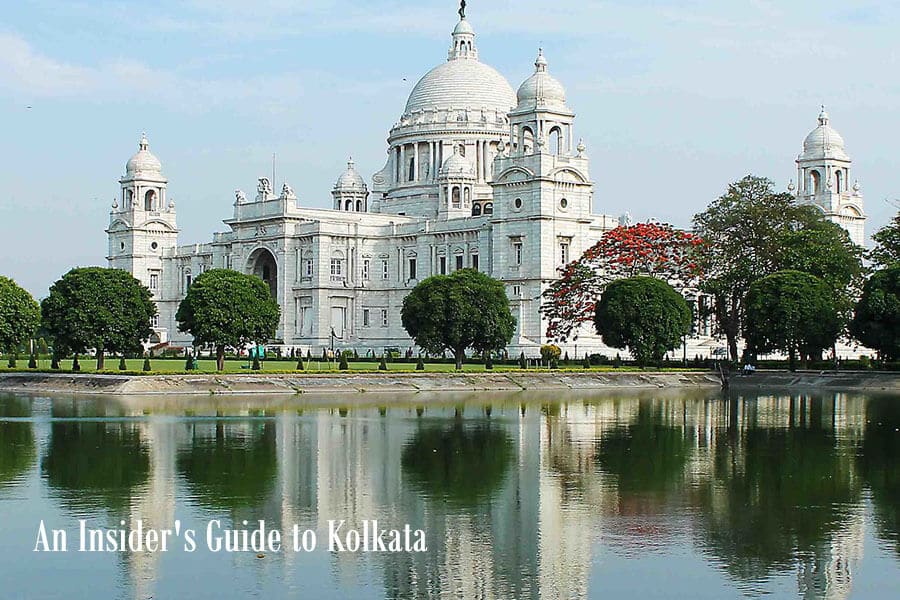An Insider’s Guide to Kolkata
The energy and excitement is always palpable in the atmosphere of Kolkata, a city where the old and the new live in peaceful co-existence, much like its multicultural community that has thrived for generations. Crowded roads, slow-moving traffic, and the continuous honking of vehicles can overwhelm you. But, once you are here you would need to dive beneath its surface and discover the many colors of the city. We take you to a journey into the alleys of the city to help you explore its true charm.
Bowbazar
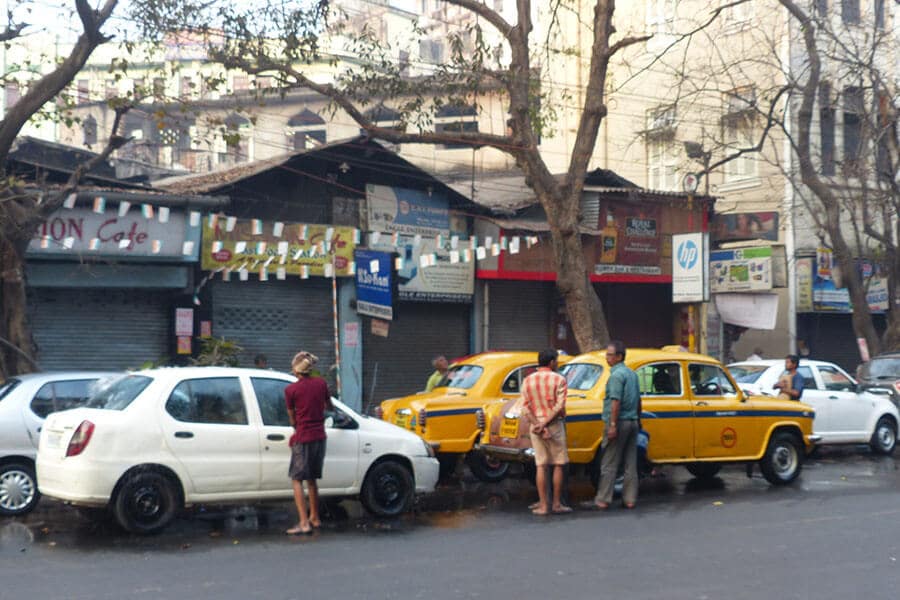
Bowbazar was the gray area of the city in the colonial era where the non-British, non-Indian population settled after Kolkata was divided into Black and White areas. Most organized photo tours will take you to this place to capture the Anglo-Asian back streets of Bowbazar marked with red-bricked buildings and contrast dark green shutters.
Breakfast at Territi bazaar

Even unknown to many city dwellers, this tiny street is a hidden gem of Kolkata. Located at a close distance from Central Metro Station, the market bursts into activity right from 5 am in the morning. The place was once inhabited by more than 20,000 Chinese who came to India back in the 1780s, and had since then, made rich contributions to shape the city’s food culture. While most of the Chinese food sellers have moved to Chinatown in the eastern peripheries of Kolkata, Territi bazaar still sells some authentic Chinese food that will haunt your taste buds for a long long time. Visit this place between 6 am to 8 am and find the Chinese women and men selling home-cooked Chinese delicacies like Dimsums, chicken/ fish ball soup, baos and dumplings, chicken/ pork pies and a lot more.
China Town
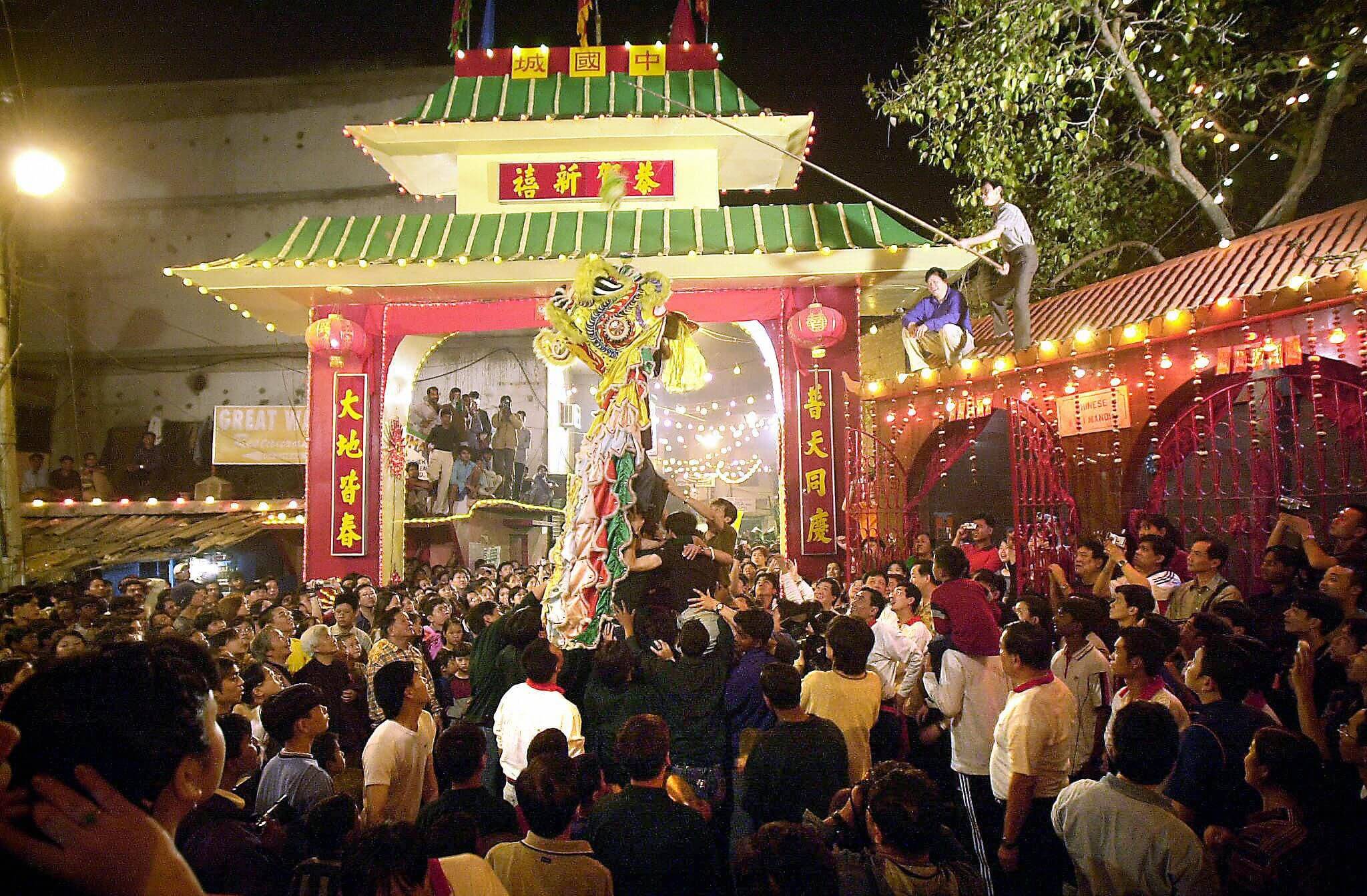
China Town in Kolkata is mainly known for its Chinese eateries that serve great Chinese food at lower prices. But, there is more to this place than just-food. You can find stuff that isn’t available anywhere else.
Ting Son and Co. in China Town is still carrying the legacy of best-handcrafted shoes in the city in the midst of large scale incursion by the shopping malls and eCommerce sites. You can find stylish made-to-order moccasins and brogues, here.
While in China Town, you can get your own copy of the Chinese Newspaper. The Chinese daily is published from Tangra and contains news from international and national newspapers as well as electronic media. This newspaper is the only broadsheet in Chinese published in India.
If you happen to be in Kolkata in February, you can witness Dragon dance shows, an essential part of the Chinese New Year celebrations that stretch for 10-15 days. The dancers perform in groups and visit the establishments and households in the locality to bless them for the New Year.
Chinese Temples
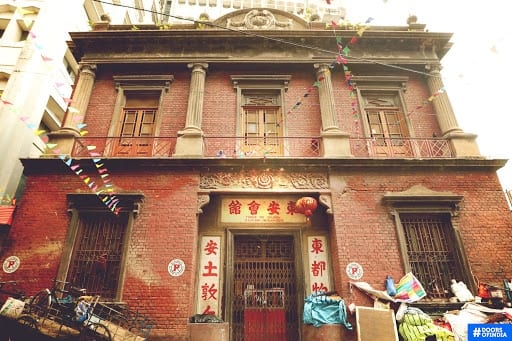
Kolkata is home to some very traditional Chinese temples, one can spot in the narrow bylanes of Territi bazaar. The temples here bear the ‘church’ tag from the British colonial administrative practices. In the past, these temples played a pivotal role as centers of social and cultural development for the Chinese community. Till today, the Chinese people come together in the evenings to pray, socialize and celebrate festivals.
Sea Ip Church
This temple is more than 100 years old and is dedicated to Guan Yin, the goddess of kindness, mercy, and compassion. It is the easiest to locate all the six Chinese temples in Territi Bazaar. To visit this temple you have to come to the Indian Exchange Place (Extension) and you can find the building located at one side of the Kolkata Improvement Trust. Once you reach here, the sloped roof in red with inverted porcelain fishes will attract your attention instantly. The temple is on the top floor of the building and has the main shrine and a chapel. The numerous idols and statues of Chinese gods and goddesses, roof and wall hangings can be seen here. If you are lucky you may get the chance to witness a religious ceremony in the temple.
Toong On Church
As you leave the Indian Exchange Place (Extension) and walk towards the Kolkata Telephone Kendra, you will come across a beautiful two-storied red-bricked building. On the first floor of this building was the Toong On Church and the top floor housed the oldest Chinese restaurant of Kolkata, the famous Nanking Restaurant. Set up in 1924, the restaurant was famed for its authentic Chinese food. Bollywood stars like Dilip Kumar, Shammi Kapoor, and Meena Kumari would come to Nanking during their visits to Kolkata. Filmmaker Dibakar Banerjee portrayed Nanking of the 1940s in his thriller Detective Byomkesh Bakshi.
The good days of Nanking could not last beyond the 1980s when the restaurant had to close down owing to a property dispute which has not been settled yet. Toong On Church moved to Bow Street in Bou Bazar after the building was locked under a court order, but Nanking Restaurant did not start entertaining food lovers from a different address.
Gee Hing Church
Walk to Blackburn Lane from India Exchange Place to find Gee Hing Church housed on top of the Chen’s Carpentry Shop. This temple remains closed on most of the days which makes it difficult to access the place. The deity of the temple is Kwan Kun, the Chinese God of the Sea. There is a framed picture of The God in an intricately carved metallic and wooden altar. The temple also has Gee Hing Club which is famous Mahjong sessions. The two rooms are full of richly carved wooden furniture pieces which are sadly in a sorry state due to lack of maintenance.
Sea Voi Yune Leong Futh Church
Originally founded in 1892, the temple went through large scale renovation in 1908. This date is often confused as its year of establishment Sea Voi Leong Futh Church is the smallest of all the six Chinese temples in Tiretti Bazar. Even though it is housed in a single room, its elegance and rich décor make up for its small size. Chinese call Lord Buddha by the name of Futh, but one can see two idols of ancient Chinese gods at the altar. The set of weapons, the wonderful wall and roof hangings and several statues and images of Chinese Gods and Goddesses is something worth noting.
Choonghee Dong Thien Haue Church
Set up in 1859, this temple has a history of more than 150 years attached to it. Choonghee Dong Thien Haue Church is housed in a building located at Damzen & Blackburn Lane on the first floor of a worn outbuilding but is pretty difficult to find. The temple is dedicated to Kwan Kun, the Chinese God of Fortune and prayers are offered here daily. The artifacts and idols that can be seen in the two rooms of the temple can be seen in a rundown condition. The mosaic floor has lost its beautiful appearance due to years of neglect. But, coming to these temples allows one to get a glimpse of the past while some of it still remains.
Nam Soon Church
Nam Soon Church is also difficult to locate, but if you manage to here, you will like that you made the effort walking through the narrow, labyrinthine Damzen Lane. The temple is the oldest of all the six Chinese temples in the area and is also the most spacious with a big courtyard winding. The temple with its soothing and calm interiors and spaciousness present a stark contrast against its surroundings.
The Chinese Goddess of war, mercy, and love, Kwan Yin is worshipped in this temple. The war companions of the Goddess are also housed in two separate altars. One can also behold the beautiful roof and wall hangings, different images and statues of various Chinese Gods and Goddesses and a set of weapons in the temple.
Park Street Cemetry
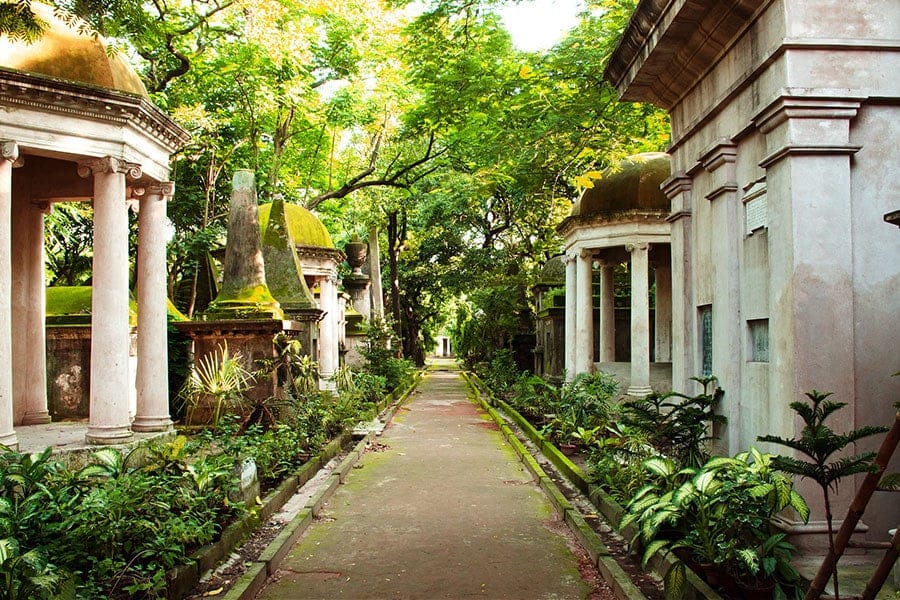
This place is tagged as haunted by most, but the solitude and the serenity of the place together with the history it encapsulates is something which you will actually get to experience here. Now, a heritage site conserved by the Archeological Survey of India (ASI), the cemetery 1600 grave with tablets, epitaphs, and cenotaphs. It became functional from 1767 and was among the first cemeteries created separately from a church. Spread across an area of 8 acres, the cemetery was known as the ‘Great Christian Burial ground’ in Asia.
The cemetery served as the burial ground for the people who had moved to India from Europe. It has the graves of some of the most distinguished people of the era. Most noted among them are Sir William Jones, founder of Asiatic Society, Henry Louis Vivian Derozio, the founder of the Young Bengal Movement, Michael Madhusudan Dutta, the anglicized and venerated Bengali poet, C. F. Andrews, Walter Savage Langdon, the son of Charles Dickens, David Drummond, the educationist. The cemetery was extended towards the north in1785, but by 1840, it had to be closed due to lack of space. The Lower Circular Road Cemetery was opened covering a huge area, nearby, to work as the new burial ground for Christians.
The thick grass cover and several tall and shady trees add to the serene beauty of the place. Shrubs and flowers are grown around the graves to beautify the rectangular, circular or square tomb structures made mainly of sandstone. One can see the prominence of Gothic and Indo-Saracenic style in the structural design of the gravestones throughout the cemetery. There is also visibility of Hindu philosophy in the architectural design of tomb structures.
Street food of Kolkata
You cannot meet the real Kolkata unless you taste the lip-smacking street food from the various corners available here. There is plenty to enthrall your taste buds and satisfy your hunger pangs as you move around exploring the city. Jhalmuri, telebhaja, phucka, rolls, chowmein, momo, ghugni, kachori, singara, nimki and last but not the least chais of various types can be had. If your mouth is already watering, we will tell you where to have them the best. Vivekananda Park, Southern Avenue, Vardhan Market, College Street, Park Street, Rashbehari More, Exide More, Gariahat and Esplanade are highly recommended for savoring some top quality street food.
Princep Ghat

Built-in 1841, Prinsep Ghat was named after British Scholar James Prinsep. The Prinsep Ghat jetty was used extensively by the Royal British associates as the point of embarkation and disembarkation. The place exudes a distinct visual appeal owing to the Palladian porch built in the memory of the scholar. The monument is richly ornamented in Greek and Gothic style. For its timeless beauty, director Pradeep Sarkar had shot one of the songs of his movie Parineeta, here.
In November 2001, the West Bengal public works department restored the monument and since then the monument and the surrounding area have been maintained in a spic and span condition by the state government. There is also an attached railway station of the same name which is part of Kolkata Circular Railway.
Prinsep Ghat is the most loved picnic spot of Kolkata where people go to spend some time in peaceful enjoyment. The towering Vidyasagar Setu adds to its visual charm which when lit up in the evenings presents a stunning view. The place is seldom empty and people can be spotted enjoying a stroll along the river bank or going for a boat ride or eating from food stalls, especially in the late afternoons and in the evenings. One can spend hours watching the scenic Hooghly River with magnificent Howrah Bridge in its backdrop.
The beautified riverfront which stretches across 2 kilometers from Prinsep Ghat to Babughat is a great attraction for the visitors. The entire stretch has been decorated with landscaped gardens, fountains, and pathways.
Palaces of Kolkata
‘The city of palaces’ as Kolkata is called, still holds on to its reputation despite the fact that many palatial houses have been replaced by multi-storeyed buildings and shopping complexes. These palaces and stately mansions will give you the taste of the bygone era.
Shovabajar Rajbari
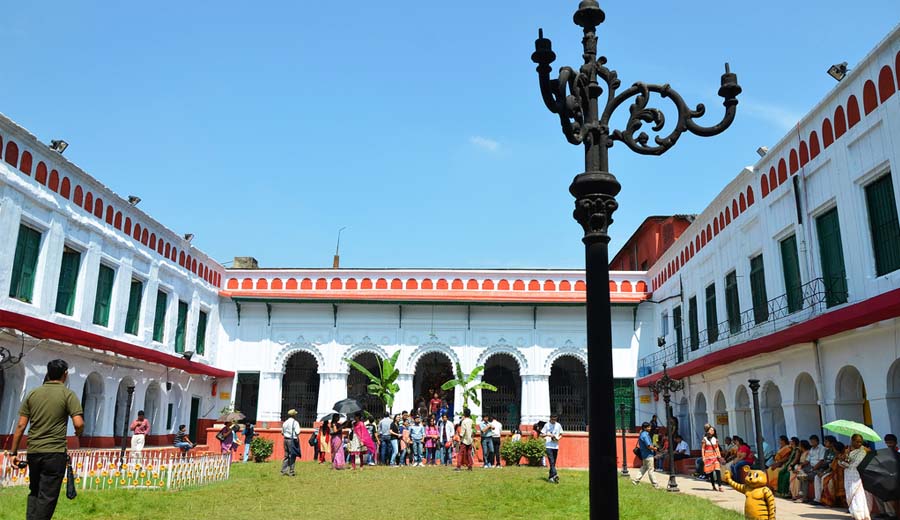
The palace was built by Raj NabaKrishna Deb in around 1757. It is accessible by a 5-minute walk from the Shova Bazaar Metro. Originally a sat-mahala palace, now only the courtyard and the thakurdalan remains in the best condition. The palace comprises of two magnificent constructions on the either side of the road and has witnessed some major historical events of the colonial era. It was here that the civic reception was held and organized by Raja Binoy Deb Bahadur to honor Swami Vivekananda after he returned from Chicago Parliament of Religions in 1897.
Marble Palace
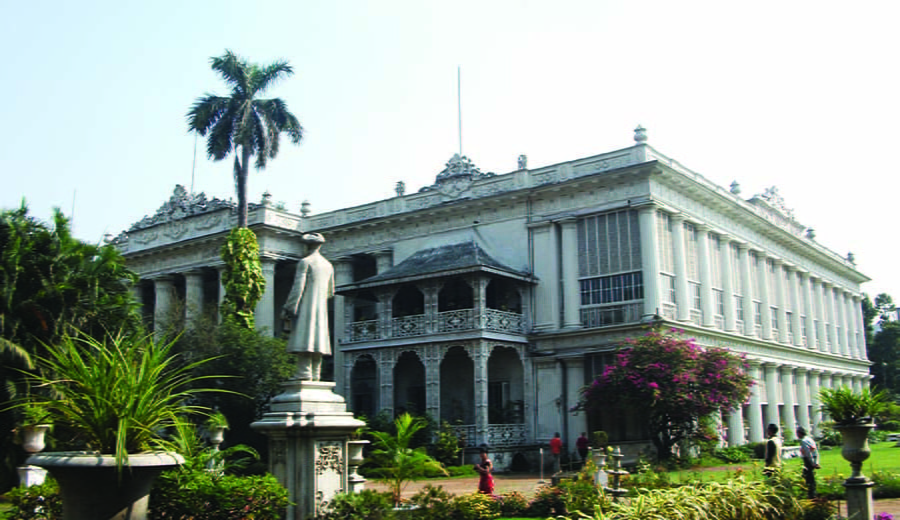
Another major icon of the aristocratic culture is the Marble Palace or the Mullick Bari. The frontage of the palace represents the Neo Classic and classic Doric/Palladian style and has fluted Corinthian pillars. The plan of the house, however, is predominantly traditional Bengali which is reflected by its open courtyard. Marble Palace was built by Raja Rajendra Mullick who was a philanthropist and an art collector. One should visit this palace to see the collection of Victorian furniture, paintings by European and Indian artists, and other works of art. The decorative items include royal busts, urns, floor-to-ceiling mirrors, clocks, chandeliers, and more. Inside the palace premises, there are lawns, gardens, a lake, and a small zoo.
Belgachia Rajbari
Now in ruins, the palace was known for its grand beauty and splendor during its heydays. In 1823, Prince Dwarkanath Tagore bought the palace and made it his garden house. He spent with open hands redesigning and redecorating the house in perfect European style. The majestic palace had 54 rooms and was considered an architectural marvel for its features. It is here, that Prince Dwarkanath entertained the British nobilities and threw lavish parties.
The palace later changed hands to Raja Pratap Chandra Sinha Bahadur of Paikpara who, too, invited the super elites of the time, like King Edward VII, Prince of Wales, and the Marquis. During this time the palace became the focal point of socio-cultural activities where drama, dance, and music were patronized.
Because of its grand opulence, Satyajit Ray chose Belagachia Palace as the location of his movies “Jalsaghar” and Ghare Baire”. The remnants of the past remind us of the glorious days of this palace which was once hailed as an icon of architectural elegance.
Pathuriaghata Tagore Palace
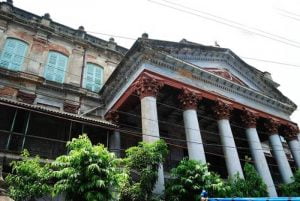
Owned by the Pathuriaghata branch of the Tagore family, it is one of the remaining marks of the glorious past of Kolkata, this palace was planned by Macintosh Burn Company from England on the lines of the castles of England. Like Windsor castle, it had a central tower 100 feet high and a flagstaff, and an imported clock from England. It had large rooms just like the castles of England. It even had an auditorium on the second floor for staging plays. The palace has lost much of its past grandeur, but one can still make out what once existed by taking a close look at it.
Jorashanko Thakurbari
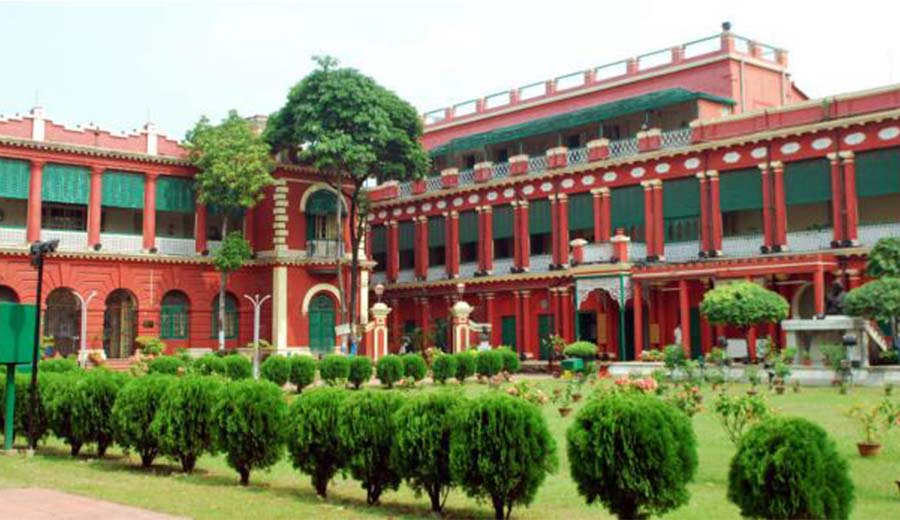
The ancestral palace of Ravindra Nath Tagore is now a brilliant museum where his artworks, photographs, literature, paintings, and cultural exchanges are on display. The magnificent palace presents an enthralling view surrounded by vast stretches of a well-maintained garden. The premises are extremely clean and all the museum halls are air-conditioned. The collection here is huge and needs time to explore. The palace is calm and one can instantly feel the difference in its ambiance from the surrounding chaos of the city.
Buggy rides around Maidan and Victoria Memorial

Well, you can visit Victoria Memorial and spend some time on the vast greens of Maidan, but that would not complete your visit to the place unless you have not been on a joyride on what is popularly called ‘Mahabharat Gari’ or buggies, around the Victoria Memorial. These ornate vehicles are nothing but buggies which are fast diminishing. A ride in one of these shining horse-driven vehicles will offer you a timeless experience.
The tram ride from Tollygunge to Esplanade
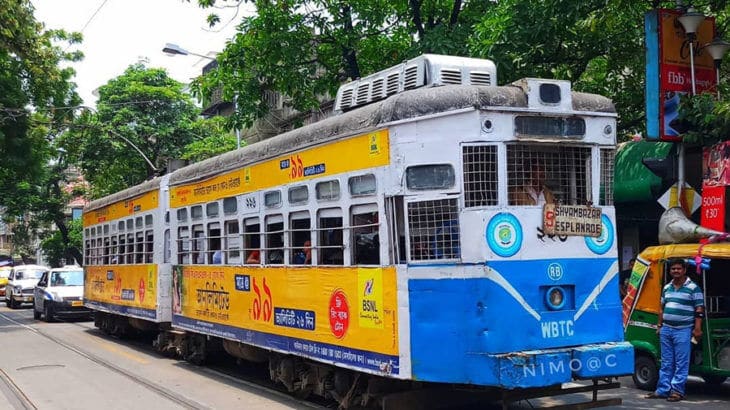
It is time taking, but you will never forget the lazy ride you had on a slow-moving tram from Kolkata’s Tollygunge to Esplanade. The first tram in this route on a winter morning is the best one to take. You can get a fair view of the heritage Kolkata and its spirit sitting by a window as the tram travels past many busy roads and footpaths and enters the Maidan area. It is an experience no one should miss.

